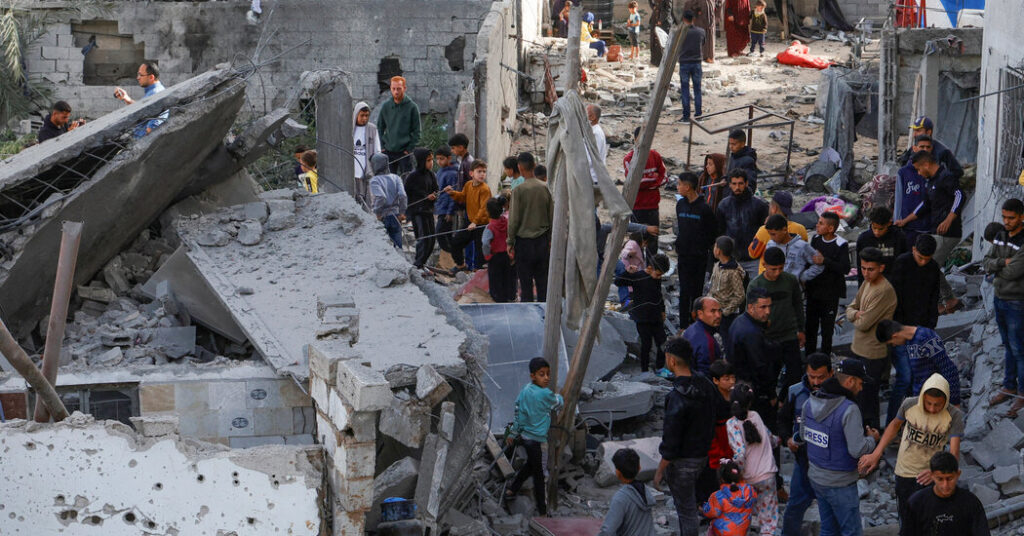Prime Minister Benjamin Netanyahu announced on Wednesday that Israel had seized a ribbon of territory in the Gaza Strip hours after his government laid out plans to seize large parts of the enclave.
The announcement adds to the growing drumbeat from Israeli officials in recent days who have suggested that Israel would shift tactics to hold territory in Gaza, at least temporarily, in an effort to pressure Hamas to free the remaining hostages. The officials have also asserted a vision for postwar Gaza in which Palestinians would move elsewhere — an idea vehemently rejected by much of the world.
Holding territory, Mr. Netanyahu said, was meant to push Hamas to return at least 59 remaining hostages the group and its allies captured on Oct. 7, 2023. “The pressure will increase until they hand them over,” he said in a filmed statement.
In the 15-month military campaign that preceded a January truce, Israeli forces stormed Gazan cities before withdrawing, leaving behind vast destruction but allowing Palestinian militants to regroup in the rubble.
In the weeks after the cease-fire took hold, many Gazans returned home, but Israel resumed its attacks in mid-March.
Now, the military appears to be planning to station forces in captured territory. The defense minister, Israel Katz, on Wednesday said newly captured areas would be “added to the security zones” that the military currently maintains in Gaza, including a buffer along the enclave’s borders with Egypt and Israel, and much of a key road in the center of the enclave.
Mr. Netanyahu said Israel would establish a security corridor, which he suggested would cut off the southern city of Rafah from the rest of the strip. The so-called Morag Corridor appeared to take its name from a former Israeli settlement in southern Gaza, from which Israel withdrew in 2005.
It was not clear how large the corridor was or how long Israel intended to hold it. The military said that it would not provide details beyond Mr. Netanyahu’s statement.
Despite their anger at Israel’s latest orders, some Palestinians in the enclave took to the streets to protest against Hamas and call on the Islamist group to end the war.
“Hamas out,” protesters chanted Wednesday at a rally in Beit Lahiya, in the northern Gaza Strip. “Enough death,” they shouted.
Hamas is likely to reject Mr. Netanyahu’s latest plan for a postwar Gaza, which includes Hamas laying down its arms, Israeli security control in Gaza and what he has called voluntary migration for Gazans.
It’s unclear whether the recent moves by Israeli amount to a bid to pressure Hamas to negotiate and make concessions, or indicate a more comprehensive plan for Gaza.
Mr. Netanyahu has repeatedly conditioned the end of the war on the dismantling of Hamas’s military wing and government, but his comments offered a detailed vision of how he thought that could be achieved.
For their part, Hamas officials have rejected ideas calling on them to give up their weapons, send their leaders into exile or accept the depopulation of Gaza. Hamas is demanding an end to the war and a full Israeli withdrawal in exchange for the release of all the hostages still held in Gaza.
Even if Palestinians were allowed to leave Gaza or were forced out, it’s not clear where they would be able to resettle. Arab countries, including neighboring Egypt, have rejected proposals first publicly floated by President Trump to relocate them to their soil, with some calling the plan tantamount to ethnic cleansing
The Israeli military resumed its attacks against Hamas in Gaza on March 18 after Israel and Hamas failed to reach an agreement to extend the cease-fire that started in January.
On Wednesday, Israeli forces struck a United Nations building in the northern city of Jabaliya where several hundred people were sheltering, said Juliette Touma, a spokeswoman for the U.N. agency for Palestinian refugees. The Israeli military said it had attacked Hamas militants hiding inside a “command-and-control” center, without providing evidence. Israel has accused Hamas of embedding in civilian areas.
Gaza’s Civil Defense emergency response organization said in a statement that seven people had been killed. The group does not distinguish between civilians and combatants in its count.
Since the cease-fire collapsed, Israeli forces have been advancing deeper into the Gaza Strip, including in the southern city of Rafah, though they have not been sweeping through Palestinian cities as they did before the truce. Both sides have been speaking to mediators about a potential deal to halt the fighting — so far without success.
The Israeli military has issued sweeping evacuation orders for parts of Gaza. More than 200,000 people in the enclave have been displaced since the cease-fire broke down, according to the United Nations.
Gaza health officials say that more than 50,000 people have been killed in the enclave since the war began after the Hamas-led attack on Israel on Oct. 7, 2023. That attack killed 1,200 people and saw 250 taken hostage to Gaza.
Gabby Sobelman, Rawan Sheikh Ahmad and Johnatan Reiss contributed reporting.

